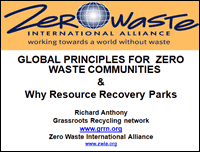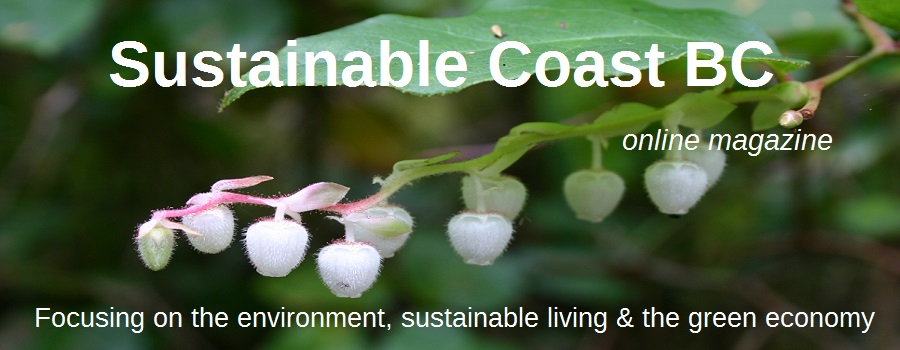News
The workshop held in Pender Harbour on May 30 was well attended by around 50 community members, SCRD representatives and committee members. The information presented centered on designing a resource recovery park for the Sunshine Coast.
The first speaker of the day was Don Marshall from Bowen Island. Don told the story of the Bowen Island Recycling Depot (BIRD). Moving from the early years of dumping everything into the chuck to a small group of women who began collecting items, initially glass, cardboard and newspapers. One resident made a glass crusher. In 1985 the group constructed a small building which was dark, wet and cold reported Marshall.
In 1994 collected items were expanded to mixed paper, cans, milk jugs and a compactor for cardboard was added. By 2007 they were able to build a new building that is bright, dry and clean. The quonset hut is set on a 60 ft. x 50 ft. concrete slab that cost them $65,000. They spent $36,000 on a compactor. They have five 40 ft. bins, 1 split bin and 1 bin for returnables.
The new facility brought up the volume they are collecting as it is user friendly. They are able to collect a larger variety of materials including plastic bags and electronic waste. They also collect construction waste two days a week.
The depot is run by a volunteer organization composed of a six person board and 24-30 volunteers that man the depot from 9 am to 2:30 pm Thursday to Monday each week. They are considered volunteer educators at the depot. Marshall said that they have lots of particpation from the island community and everyone recycles to some extent. Their volunteers are a dedicated and happy group and the depot is a social meeting place on the island.
The returned bottles are collected in a 40 ft. container which is filled every two weeks. Different non-profit groups take turns sorting the returnables and receive the money collected. Usually this runs around $2000 per month.
Marshall said, " The purity of our stuff is so good that the depots love to see us coming." This is attributed to a well-trained staff and organized depot.
BIRD is supported by the municipal council with a $5000 grant. The income from their recovery sales is $3000 to $4000 per month. The munincipality has a contract with a waste management company for all waste.
Marshall reported the following statistics on their depot for 2009:
Recycling -(kg) glass - 30,000; newspaper - 37,000; mixed paper - 95,000; corrugated cardboard - 96,000; tin cans/metal - 19,669; mixed plastics - 17,430; milk jugs - 3300
Assorted recycling - fridges - 80, freezers - 20, batteries - 100, tires - 75, propane - 40
Resource Recovery Park
After a lunch break, the afternoon session was devoted to information on designing a resource recovery park with Richard Anthony of Richard Anthony Associates and a board member of ZWIA, Zero Waste International Alliance. Anthony began by reminding everyone that "someone's waste is someone else's resource."
He gave examples of how waste is turned into a resource. He told the story of working on Zero Waste in Cork, Ireland. A particpant told him of all his waste wood material. The man's business was making solid core doors from mahogany. He spent thousands of dollars to have the waste ends hauled away. Anthony recommended that he contact local artists and make the wood waste available for them to use in designing a new product. This saved the business money and gave jobs and new business to local artists.
Anthony said we have now moved beyond recycling to reuse. In order to deal with the 2000 lbs. of garbage that each person generates per year, we must follow the Zero Waste principles and source separate items for the highest and best use.
He stressed the Zero Waste Goals of :
- Producer responsibility in production and design
- Consumer responsibility in consumption, discard, use and disposal
- Political responsibility to bring the community and industry together in a harmonious whole
He said government should make Zero Waste their goal because it reduces climate change, promotes local sustainability, protects health and creates green jobs.
 In designing a resource recovery park he said it is important to make it easy to use, such as a bunker system. A RRP for the PH area would probably need to be on a four acre site. A drawing of an example of a RRP was shown to the participants. It illustrated an education centre, drop-off areas, recovery areas, re-sale areas, and pick-up areas for recovered materials.
In designing a resource recovery park he said it is important to make it easy to use, such as a bunker system. A RRP for the PH area would probably need to be on a four acre site. A drawing of an example of a RRP was shown to the participants. It illustrated an education centre, drop-off areas, recovery areas, re-sale areas, and pick-up areas for recovered materials.
He said it was important that the Zero Waste principles of "no bury, no burn" be adopted and that benchmarks and a timeline be established. He also said it was important that the community be engaged. "You need to find out what people want and need," he said. " You should involve all organizations and challenge everyone to pursue Zero Waste."
Anthony also stressed that ZW assessments must be made that collect data, identify waste produced and use that information as a baseline for determining your markets. A study must also be made of the residuals and the last 10% that goes to landfill.
New rules and incentives must be implimented including: manditory source separation, getting organics out, manditory recycling of materials and take-back of materials by the manufacturers that cannot be reused or recycled.
At the end of the workshop discussion, a motion was made by resident Jim Hall and seconded by Area A director Eric Graham to take to the SCRD board of directors wetting a goal of 90% Zero Waste by 2020.
